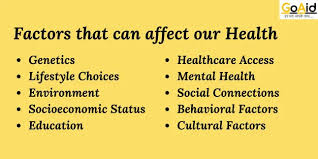What are the 10 factors that affect health?
10 Factors That Affect Health: A Comprehensive Analysis

Introduction
Health is one of the most valuable assets a person can possess, yet it is influenced by far more than just visits to the doctor or the absence of disease. Health is shaped by a wide variety of interconnected factors, ranging from personal behaviors to societal systems. These factors, known as the determinants of health, are key to understanding why some people enjoy better health than others and why health inequalities persist in many parts of the world.
This essay explores ten major factors that affect health, how they interact, and why addressing them is critical for promoting well-being and achieving health equity.
1. Genetics and Biology
Overview:
Genetics and biology refer to the inherited characteristics that influence a person’s health. This includes genes passed down from parents as well as biological factors such as age, sex, and hormonal differences.
Impact:
- Some individuals inherit genetic predispositions to conditions like diabetes, cancer, or heart disease.
- Age affects risk: older adults are more vulnerable to chronic illnesses.
- Biological sex can influence the prevalence and symptoms of diseases (e.g., heart disease often presents differently in men and women).
Note:
While we can’t change our genes, understanding them can help in early diagnosis, prevention, and management of certain health conditions.
2. Lifestyle and Health Behaviors
Overview:
Lifestyle refers to the personal choices people make in their daily lives, such as diet, exercise, smoking, alcohol consumption, sleep, and stress management.
Impact:
- Unhealthy diets contribute to obesity, diabetes, and cardiovascular diseases.
- Lack of physical activity increases the risk of numerous chronic conditions.
- Smoking and substance abuse are leading preventable causes of disease and death.
- High stress levels can lead to mental and physical health issues, including hypertension and depression.
Why it matters:
Health behaviors are among the most modifiable factors. Public health campaigns often focus on improving these behaviors to reduce disease burdens.
3. Socioeconomic Status (SES)
Overview:
SES includes income level, educational attainment, employment status, and occupational conditions. It plays a critical role in shaping access to resources and opportunities.
Impact:
- People with lower income often face food insecurity, substandard housing, and unsafe neighborhoods.
- Education affects health literacy, job prospects, and healthy decision-making.
- Employment affects access to health insurance, benefits, and safe working environments.
Key point:
Health inequalities are often rooted in socioeconomic disparities. Better SES is typically linked to better health outcomes and longer life expectancy.
4. Education
Overview:
Education is a key social determinant of health, influencing not only job opportunities and income but also health knowledge and behaviors.
Impact:
- Individuals with higher education levels tend to live healthier lives, make informed health decisions, and access healthcare more easily.
- Education affects literacy, including health literacy, which is critical for understanding medical information and navigating healthcare systems.
Why it’s important:
Education empowers people with knowledge, skills, and confidence to lead healthier lives.
5. Environment and Living Conditions
Overview:
The physical and social environment includes housing quality, neighborhood safety, air and water quality, and availability of green spaces.
Impact:
- Poor housing may expose individuals to mold, pests, or lead, contributing to respiratory and other health problems.
- Unsafe neighborhoods can limit outdoor physical activity and increase injury or trauma risks.
- Pollution contributes to respiratory and cardiovascular diseases.
- Access to nature and green spaces supports mental and physical health.
Key message:
Where people live has a profound effect on their well-being. Urban planning and environmental regulation are essential to community health.
6. Access to Healthcare Services
Overview:
Access includes availability, affordability, and acceptability of healthcare services, from preventive care to emergency treatment.
Impact:
- Lack of access can result in delayed diagnoses, untreated illnesses, and poor disease management.
- Financial barriers may discourage people from seeking timely care.
- Cultural or linguistic barriers can lead to miscommunication and mistrust between patients and providers.
Example:
Someone living in a rural area with no nearby clinic may struggle to manage a chronic condition, leading to complications that could have been prevented.
7. Social Support Networks
Overview:
Support from family, friends, and communities can significantly influence mental and emotional health, as well as health-related behaviors.
Impact:
- Emotional support can reduce stress, anxiety, and depression.
- Strong relationships encourage healthier habits, such as eating well or seeking medical help when needed.
- Isolation and loneliness have been linked to increased mortality rates, especially among older adults.
Conclusion:
Social connection is not just a luxury—it is a vital health resource.
8. Culture and Social Norms
Overview:
Cultural beliefs and societal norms shape attitudes toward health, illness, diet, exercise, medical care, and more.
Impact:
- Cultural stigmas may prevent individuals from seeking mental health care.
- Norms around gender roles can influence health behaviors (e.g., men may be less likely to seek care due to cultural expectations about toughness).
- Dietary traditions may affect nutritional choices, for better or worse.
Note:
Cultural competence in healthcare settings is crucial to delivering respectful, effective care.
9. Government Policies and Health Systems
Overview:
Policy decisions and the structure of healthcare systems determine how services are delivered, who gets access, and how much they cost.
Impact:
- Countries with universal healthcare systems generally see better overall health outcomes and lower health inequality.
- Policies on smoking, alcohol, food labeling, and urban planning can significantly affect population health.
- Lack of investment in preventive care can increase long-term healthcare costs and disease burdens.
Why it matters:
Health is shaped not just by personal choices but by political and economic systems.
10. Early Life Experiences
Overview:
The conditions and exposures during childhood and adolescence set the foundation for lifelong health.
Impact:
- Poor nutrition, exposure to trauma, abuse, or neglect in early life are linked to chronic disease, mental health disorders, and lower life expectancy.
- Early education and positive socialization promote brain development, emotional regulation, and health literacy.
- Adverse Childhood Experiences (ACEs) can have long-term impacts on behavior, coping mechanisms, and physical health.
Key insight:
Investing in children’s health and development yields lifelong benefits for individuals and society.
Conclusion
Health is far more than the outcome of individual behavior or biological inheritance. It is shaped by a complex web of interrelated factors, ranging from genes and choices to environments, relationships, policies, and life experiences.
The 10 factors that affect health—genetics, behavior, socioeconomic status, education, environment, healthcare access, social support, culture, policies, and early life—work together to create patterns of well-being or vulnerability in individuals and communities.
Understanding and addressing these determinants is essential for creating health systems and societies that promote well-being for all, reduce disparities, and allow every person the opportunity to live a healthy, meaningful life.










Post Comment